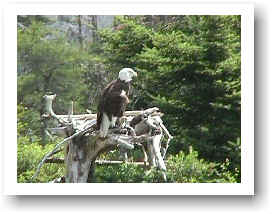
Bald Eagle
Hallaeetus leucocephalus
Status
Native to both Newfoundland and Labrador.
Habitat
Usually found near large rivers, lakes, coastal areas and nearby countryside, depending on availability of food.
Range
The Bald Eagle is the only exclusive North American eagle. Found throughout Canada, being most common along the Pacific and Atlantic coasts, but may also be found in all provinces and territories.
Food
Their primary food is fish, birds (especially waterfowl) and mammals which may be taken alive or dead. When staple food is not available, bald eagles will eat almost anything.
Predators/Threats
Loss of habitat, use of pesticides, human disturbance at nesting sites, illegal shooting and collisions with power lines all affect bald eagle populations.
Lifespan
Recorded at 21 years, 11 months in captivity.
Appearance
Adult plumage is dark brown (almost black) with snowy white head and tail; yellow bill, eyes and feet. The tail and head of immature eagles are brown like the body (slightly lighter than adult). Their head and tail become white at 4-5 years of age. The Bald Eagle’s eyes are yellowish grey; cere greyish tinged with yellow. The bill is brownish and legs are yellow.
Breeding Biology
Some pairs may mate for life. The nest of Bald Eagles is the largest of any bird in North America. One to three (usually two) dull white eggs are laid several days apart and are incubated by both the female and the male over a period of about five weeks.
Average Weight/Measurements
Length of (2.5 – 3 ft)(0.9 m); wingspan of (6 – 7.5 ft)(1.8 – 2.3 m).; weight of (9.5 lbs)(4.3 kg).
Notes:
- Bald Eagles take over four years to attain a pure white head and tail.
- Immature Bald Eagles may be confused with Golden Eagles, but can be identified by their large head, heavier bill and unfeathered yellow legs.
- Largest of all nests (one reported as being 3m across and 6m tall). Instead of building a new nest each season, bald eagles will keep building on top of the old nest.
- The largest nestling always eats first and may even kill the smallest sibling.
- Young Bald Eagles grow rapidly – from about 90g at hatching to an average of 4000g (males) and 5100 (females) in just two months.
At Salmonier Nature Park
- Bald Eagles at Salmonier Nature Park are unreleasable to the wild due to wing injuries.
